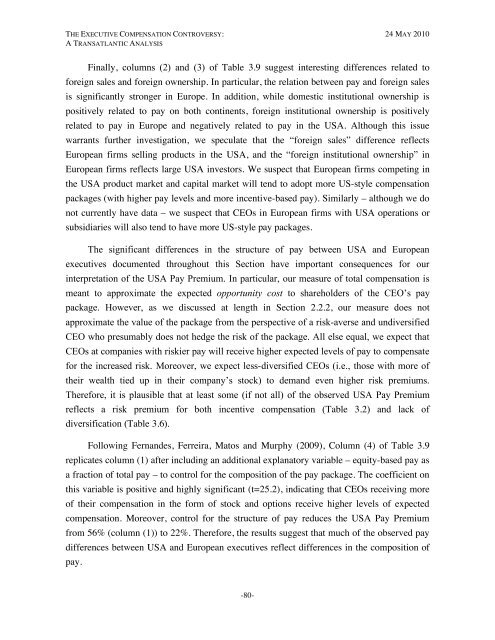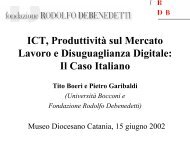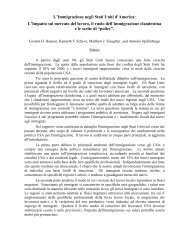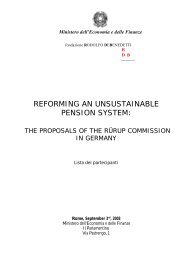The Executive Compensation Controversy - Fondazione Rodolfo ...
The Executive Compensation Controversy - Fondazione Rodolfo ...
The Executive Compensation Controversy - Fondazione Rodolfo ...
You also want an ePaper? Increase the reach of your titles
YUMPU automatically turns print PDFs into web optimized ePapers that Google loves.
THE EXECUTIVE COMPENSATION CONTROVERSY: 24 MAY 2010A TRANSATLANTIC ANALYSISFinally, columns (2) and (3) of Table 3.9 suggest interesting differences related toforeign sales and foreign ownership. In particular, the relation between pay and foreign salesis significantly stronger in Europe. In addition, while domestic institutional ownership ispositively related to pay on both continents, foreign institutional ownership is positivelyrelated to pay in Europe and negatively related to pay in the USA. Although this issuewarrants further investigation, we speculate that the “foreign sales” difference reflectsEuropean firms selling products in the USA, and the “foreign institutional ownership” inEuropean firms reflects large USA investors. We suspect that European firms competing inthe USA product market and capital market will tend to adopt more US-style compensationpackages (with higher pay levels and more incentive-based pay). Similarly – although we donot currently have data – we suspect that CEOs in European firms with USA operations orsubsidiaries will also tend to have more US-style pay packages.<strong>The</strong> significant differences in the structure of pay between USA and Europeanexecutives documented throughout this Section have important consequences for ourinterpretation of the USA Pay Premium. In particular, our measure of total compensation ismeant to approximate the expected opportunity cost to shareholders of the CEO’s paypackage. However, as we discussed at length in Section 2.2.2, our measure does notapproximate the value of the package from the perspective of a risk-averse and undiversifiedCEO who presumably does not hedge the risk of the package. All else equal, we expect thatCEOs at companies with riskier pay will receive higher expected levels of pay to compensatefor the increased risk. Moreover, we expect less-diversified CEOs (i.e., those with more oftheir wealth tied up in their company’s stock) to demand even higher risk premiums.<strong>The</strong>refore, it is plausible that at least some (if not all) of the observed USA Pay Premiumreflects a risk premium for both incentive compensation (Table 3.2) and lack ofdiversification (Table 3.6).Following Fernandes, Ferreira, Matos and Murphy (2009), Column (4) of Table 3.9replicates column (1) after including an additional explanatory variable – equity-based pay asa fraction of total pay – to control for the composition of the pay package. <strong>The</strong> coefficient onthis variable is positive and highly significant (t=25.2), indicating that CEOs receiving moreof their compensation in the form of stock and options receive higher levels of expectedcompensation. Moreover, control for the structure of pay reduces the USA Pay Premiumfrom 56% (column (1)) to 22%. <strong>The</strong>refore, the results suggest that much of the observed paydifferences between USA and European executives reflect differences in the composition ofpay.-80-









